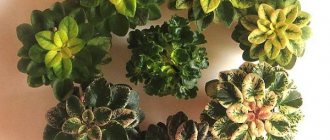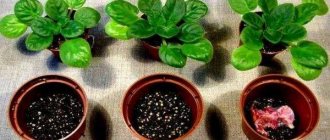History of creation, decoding of the abbreviation “LE”
It was bred in Ukraine by the famous breeder E. Lebetskaya.
All varieties have the prefix LE in their name.
A distinctive feature of the Saintpaulias grown by Elena is the presence of an even, symmetrical rosette.
This variety of violet looks impressive thanks to its rose-like flowers.
Photo and description of the variety
The petals are white or pinkish, sometimes with crimson splashes, with a corrugated wavy border.
The flowers themselves are not large (4-5 cm), but form a lush “cap”.
The peduncle produces a large number of flowers, the first of which are large and massive, the lower ones are smaller.
The compass rose has large and wavy leaves that are dark green in color.
Characteristics. Saintpaulia “sport”
A distinctive feature of this variety is its ability to go into sports.
Sport is the difference between Saintpaulia and the mother plant (variety). The new plant has no varietal characteristics or they are barely noticeable.
It happens that the shape and color of the leaf is the same for both the variety and the sport. To see the difference you need to wait until flowering.
Often sports produce bright red or plain pink flowers, which also look impressive. When changing the sheet, the first thing that disappears is the waviness of the sheet.
If you collect varietal violets, pay attention to other spectacular varieties: “Raisin”, “Chimera”, “Dance of Galaxies” and “Frosty Cherry”.
Extraordinary stages of life
Yucca garden: planting and care, photos, cultivation features, reproduction
Cultivation of this variety can please flower growers with the almost complete absence of unpleasant surprises that can damage the decorative condition of the plant. And the correct agricultural technology can easily help you cope with the small nuances of Saintpaulia growth.
Difficulty of independent growth in indoor collections
The violet of the presented variety is distinguished by its unpretentious character, easy adaptation to life in the microclimate of any premises and spectacular decorativeness.
The varietal characteristics help Saintpaulia maintain the fresh appearance of the corollas for a very long time, which certainly pleases violet growers.
Other favorable features of the violet’s appearance include:
- quick and independent formation of sockets;
- compact neatness of a leafy bush;
- a marvelous combination of terry-marshmallow-shaped corollas and the watercolor technique of applying tonal shades;
- earlier flowering and gorgeous caps due to the many flower stalks;
- a large number of children.
The nuances of the development of Saintpaulia include:
- extremely slow opening of buds;
- waviness of the leaf plates and the presence of a “teaspoon” effect on them;
- some weakness of peduncles towards the end of flowering due to the heaviness of the caps - calcium nitrate will help correct this situation with foliar feeding during the budding period.
Breeding specifics
Reproduction is carried out purely vegetatively:
- children from the sheet;
- layering from mature plants.
Leaf propagation.
The violet variety is distinguished by high fertility and rapid maturation of children.
Reaction of flowers to the thermal component
Excessive heat when cultivating a plant in the microclimate of a home collection can cause the flowers to fade into a thick pink color until the tone is almost completely smoothed out and the contour edging disappears.
To preserve the decorative integrity of flowering specimens, it is recommended to especially protect them from elevated temperatures at the time of flowering.
CAREFULLY! You should not allow sharp temperature contrasts and cold drafts in a room with blooming violets - there is a danger of failure of flowering and shedding of buds.
Pedicel format
Varietal violet flowers always form strong, optimally growing peduncles that are capable of holding heavy corolla caps in an upright position.
Only towards the end of flowering may the flower stalks lack strength and the caps tilt slightly due to the weight of the voluminous buds.
Flowering formula
PT-Santa Rosa forms flower stalks early and in large quantities - this allows it, with relatively small dimensions of the corollas, to form luxurious caps, the effectiveness of which increases with each subsequent wave of flowering.
Growing rules
The wind rose, like many other violets, loves light and warmth. In order for the plant to please you with flowers and not cause a lot of trouble, you need to comply with some care conditions.
Priming
Like any violets, Windrose prefers light, airy and permeable soil. You can buy it at a specialty store or mix it yourself.
The variety requires constant replanting due to increased sensitivity to acidic soil.
Ground eggshells or chalk will help reduce soil acidity. When mixing soil at home, sterilize all components.
Site selection and temperature
Wind rose, like other violets, does not tolerate direct sunlight, drafts and temperature changes.
Optimal temperature for growing +18 +25.
Humidity is also the main component when growing Saintpaulia and is in the range of 40-50%.
To form a neat rosette, the pot should be periodically turned towards the light.
Choosing a pot
Sometimes the leaves of the Compass Rose produce a large, slightly spreading rosette. To prevent this from happening, choose a pot for planting with a diameter half the size of the rosette.
Due to the proximity of the roots to the surface, the pots should not be deep.
Watering
Several indicators should be taken into account
- How do you water violets?
- Season. In summer, water 1-2 times a week, in winter as it dries out.
- Age and growth of the plant.
- Pot size.
- Soil composition.
- Ambient temperature.
From top to pallet
Violets can be watered either in the tray or from above.
When watering an earthen clod, it is important not to get water on the leaves of the plant.
If you want to reduce the volume of the outlet, do not use the wick method when watering.
However, this method is indispensable in case of long-term absence and sometimes it is necessary to use it.
Plant care
Violet Windrose is extremely demanding on the level of soil moisture and the presence in it of all the nutrients necessary for development. Therefore, proper organization of watering and fertilizing are the main measures for caring for the plant.
Popular articles Aphids on houseplants - how to fight at home
Watering rules
Watering violets is carried out strictly at the root, evenly moistening the soil. Only soft water is used for irrigation: tap water, melt water or filtered spring water, standing for 1-2 days.
Experienced flower growers advise using wick watering of violets for this variety, when the plant independently regulates the level of soil moisture. Such watering is organized using a wick made of rope 0.15-0.20 centimeters thick. One end of the rope is placed in the soil of the flower pot, and the second is released through the drainage hole and placed in a container of water over which the pot is placed. Water enters the soil through the wick in the volume required by the plant’s root system.
Wick watering completely eliminates the risk of waterlogging or drying out the soil, which is very harmful for the Windrose violet.
Organization of fertilizing
To feed the Windrose violet, mineral fertilizers intended for flowering indoor plants are used. The ideal option is to use special fertilizers for violets.
Violets of the Wind Rose variety require periodic feeding.
The feeding regime depends on the time of year:
- in spring and summer – once every 10-14 days;
- in autumn - once every 30 days;
- In winter, fertilizing is not carried out.
During the period of active growth, violets need nitrogen fertilizers to promote leaf growth. During the set of buds, the nitrogen content in fertilizing is reduced to a minimum, and during flowering it is completely eliminated. A flowering plant needs phosphorus and potassium.
Transfer rules
Violet Windrose is demanding on soil nutrition, so it needs regular replanting. It is impossible to keep a flower in one soil for a long time, even with frequent feeding, since the soil is depleted and cannot provide the root system with the necessary nutrition. In addition, the old soil becomes acidic, which can destroy the violet, since its roots cannot tolerate acid.
The violet transplant schedule depends on the age of the plant:
- 1-2 years – twice a year, in spring and autumn;
- From 3 years – once a year in the spring.
Violets should not be planted in a pot that is too large.
Unscheduled transplants are necessary when a whitish coating appears on the soil surface and in case of rotting of the root system. It is also necessary to replant the violet if children have formed around the mother rosette. This often happens if the violet is planted in a pot that is too large or if it is over-fed with nitrogen fertilizers. Children must be removed. For a violet to bloom, only one rosette must grow in the pot.
Indoor violets are transplanted using the transshipment method. A new pot for the plant is selected 2-3 centimeters larger than the previous one. The soil for growing violets can be purchased specially prepared or prepared independently from leaf and turf soil, peat, sand and humus. For looseness, vermiculite or sphagnum moss is added to the mixture.
When replanting, you need to carefully examine the roots of the plant. Healthy roots are white, without spots or rotten areas. If the roots are yellowish or brown, it means they are affected by gilly or fungus. Such roots need to be cut off, otherwise they will cause the entire root system of the violet to rot and the plant will soon die.
During transplantation, violets from the third year of life must be rejuvenated by removing part of the roots and tearing off the lower leaves. After removing the leaves, the stem is buried down to the second row of leaves. After this procedure, new, young roots will begin to grow on the bare stem.
Reproduction
Violets are bred in several ways
| Reproduction method | Process |
| Rooting cuttings in water |
|
| Rooting cuttings in the ground |
|
| Rooting with leaf fragments |
|
| Rooting by stepson |
|
| Rooting with a peduncle |
|
| Children |
|
| Seeds |
|
Before cutting All tools are processed. When propagated by cuttings, the leaves must be healthy and without damage.
Many varietal violets can be easily propagated by leaves. For example, the “Wedding Bouquet” variety.
Care instructions
Caring for Saintpaulia LE-Rose of the Winds includes watering, fertilizing and replanting the plant.
Watering
It is recommended to water the flower only at the root, avoiding water droplets getting on the leaves. This is due to the fleecy structure of the leaf plates, due to which water does not evaporate for a long time and does not flow from the surface of the leaf, causing it to rot.
If this is not possible, then you can water with tap water that has been pre-settled for two days. Wick watering gives good results, allowing the plant to take exactly as much moisture as it currently needs.
This method is carried out using a rope:
- a rope made of natural fibers 2 mm thick is passed through the substrate into the drain hole of the pot;
- The pot is placed on a jar of water, and the end coming out of the hole is lowered into the water.
Fertilizer
It is recommended to feed the LE-Rose of the Winds violet with special additives for Saintpaulias. The procedure is carried out in the spring and summer months - once every two weeks, and in the fall - once a month.
For two weeks after transplantation, as well as during illness, feeding Saintpaulia is prohibited. As for the type of fertilizers, when growing green mass, the main emphasis is on nitrogen-containing preparations, while flowering plants require additives based on phosphorus and potassium.
Transfer
Planned transplantation of adult Saintpaulias is carried out once a year in the spring. However, if the roots rot or a whitish coating forms on the surface of the substrate, an emergency transplant is allowed. The need for regular replanting is dictated by the acidification of the old soil, which can provoke disease and then the death of the violet.
The essence of the procedure is as follows:
- 2 cm of expanded clay is placed in a pot of slightly larger volume than the one being used and the prepared substrate or purchased mixture is poured on top;
- the container is filled with soil to 1/3 of the total volume, after which the plant is placed in the middle and the voids are carefully filled;
- then the soil around the flower is compacted and watered moderately.
Starting from the third year of life, when replanting, the plant is regularly rejuvenated - for this, part of the root shoots is removed and the lower leaves are torn off.
Pruning and shaping the bush
If you want to see a beautiful violet bush, then sometimes the leaves need to be trimmed.
The compass rose has a rather large rosette; the lower leaves are periodically removed, resulting in the trunk being “bare.”
It doesn't look nice.
It can be replanted by deepening the bare stem.
Or cut the violet and root it.
The resulting children need to be removed, they slow down flowering. If you decide to propagate your violet, the children are removed when they reach 4-5 cm.
What determines the color of flowers
In addition to frequent sports activities, it is capable of darkening the flower. Your pale pink pet may turn deep pink or even red.
There are several reasons:
- Age.
- Temperature change. The increase affects the color change of the petals. The decrease affects the increase in the green ruffle of the leaf.
- Increasing soil acidity.
The ancestors of modern violets were predominantly purple in color. Therefore, when color changes under the influence of temperatures or when going to sports, the flowers darken.
How to grow a violet from a leaf? Features of caring for Saintpaulia “Royal Lace” and “Ice Rose”.
How to preserve varietal violets
To ensure that your violet does not change in appearance after purchase and retains all varietal characteristics, follow simple rules
- Have you already tried propagating varietal violets?
- Try to maintain a constant temperature.
- Do not expose the plant to stress.
- Provide timely and quality care.
Not really
It is believed that violets that have simple colors are less prone to change.
Before purchasing “Wind Rose,” which makes you fall in love at first sight, study in detail the pros and cons of the variety.
Expert opinion
Pavlova Ekaterina Mikhailovna – agronomist, landscape designer
Participant of scientific conferences
When buying a scion or baby, be prepared to receive a plant that will be completely different from the mother one.
Also, do not forget that the Wind Rose has a large rosette. And if you admire flowers 2-3 times a year, then the rosette will be constantly before your eyes.
If Saintpaulias do not bloom at all, read the material at the link. It will be relevant for owners of most varietal Saintpaulias, for example, “Duchess” violets.
Therefore, when choosing flowers, first of all pay attention to the leaves.
Uzambara violet care at home: watering
This is perhaps the most important aspect in caring for violets. Delicate plants such as violets do not like complete drying out of the soil or excessive waterlogging and stagnation of water. Therefore, they need to be watered once every few days so that the soil in the pot is constantly moist. Excess water must be drained from the pan half an hour after watering. It is better to use settled or boiled water, at room temperature or even 2-3 degrees warmer. If you water your violet with cold water, it will stress its sensitive root system.
When watering, try not to get water on the leaves or pour it into the growing point in the center of the rosette. It is best to use a watering can with a narrow, thin spout, adding water little by little under the leaves around the entire circumference of the pot.
If water does get on the leaves or at the growing point, carefully blot it with a soft cloth.
It is also very convenient to water violets through a tray: pour water into it and wait until as much liquid is absorbed into the ground as it can absorb. After half an hour, drain the remaining water from the pan. If all the water was absorbed, it means that the earthen ball was overdried, and, most likely, the soil could not be sufficiently moistened. Pour water into the tray again and after half an hour, drain the remainder.











